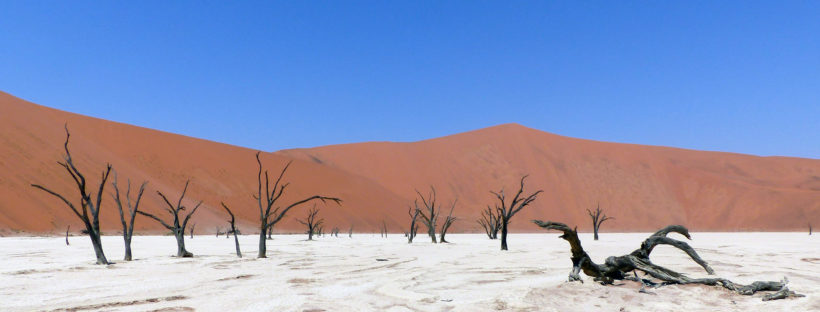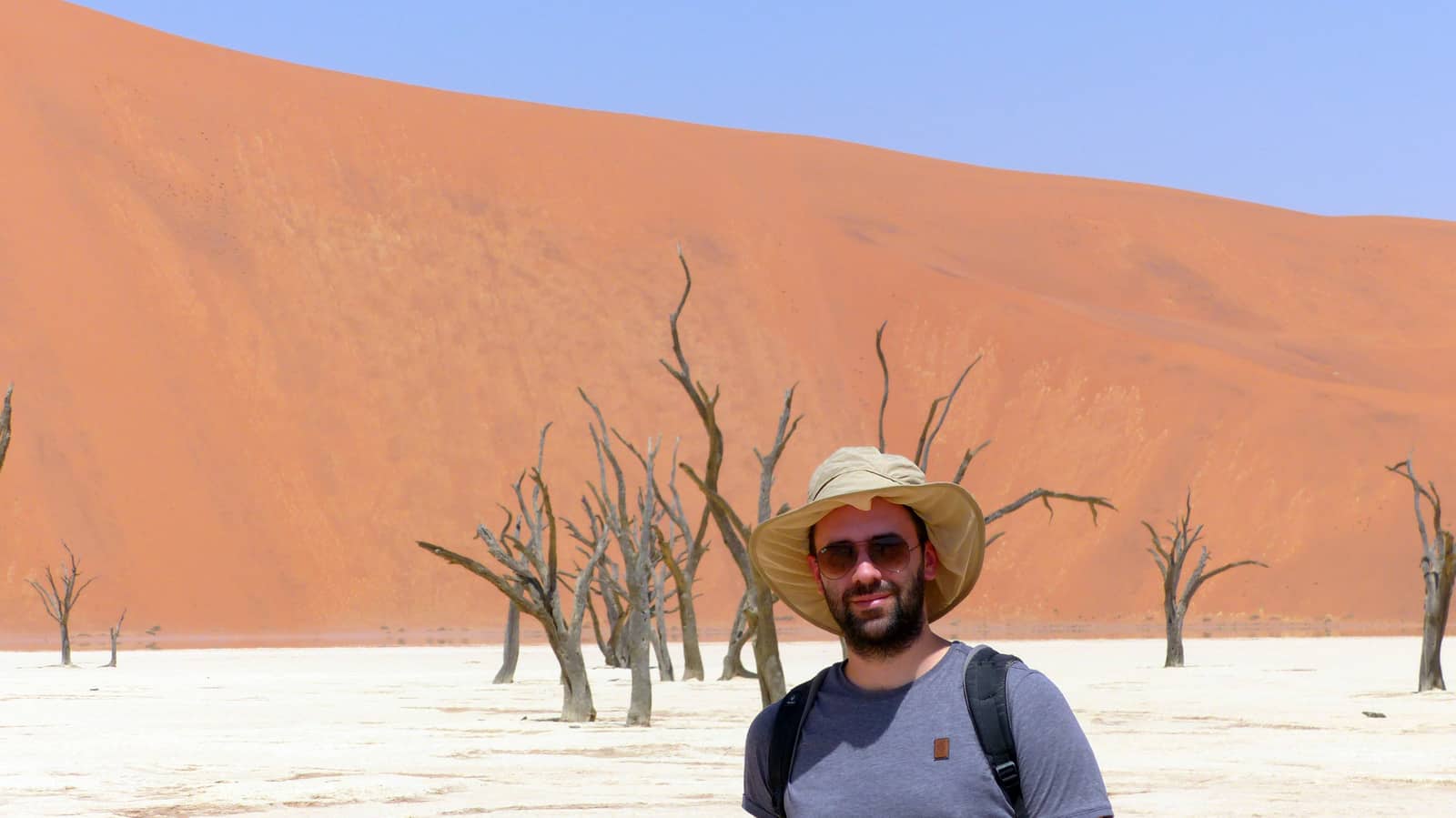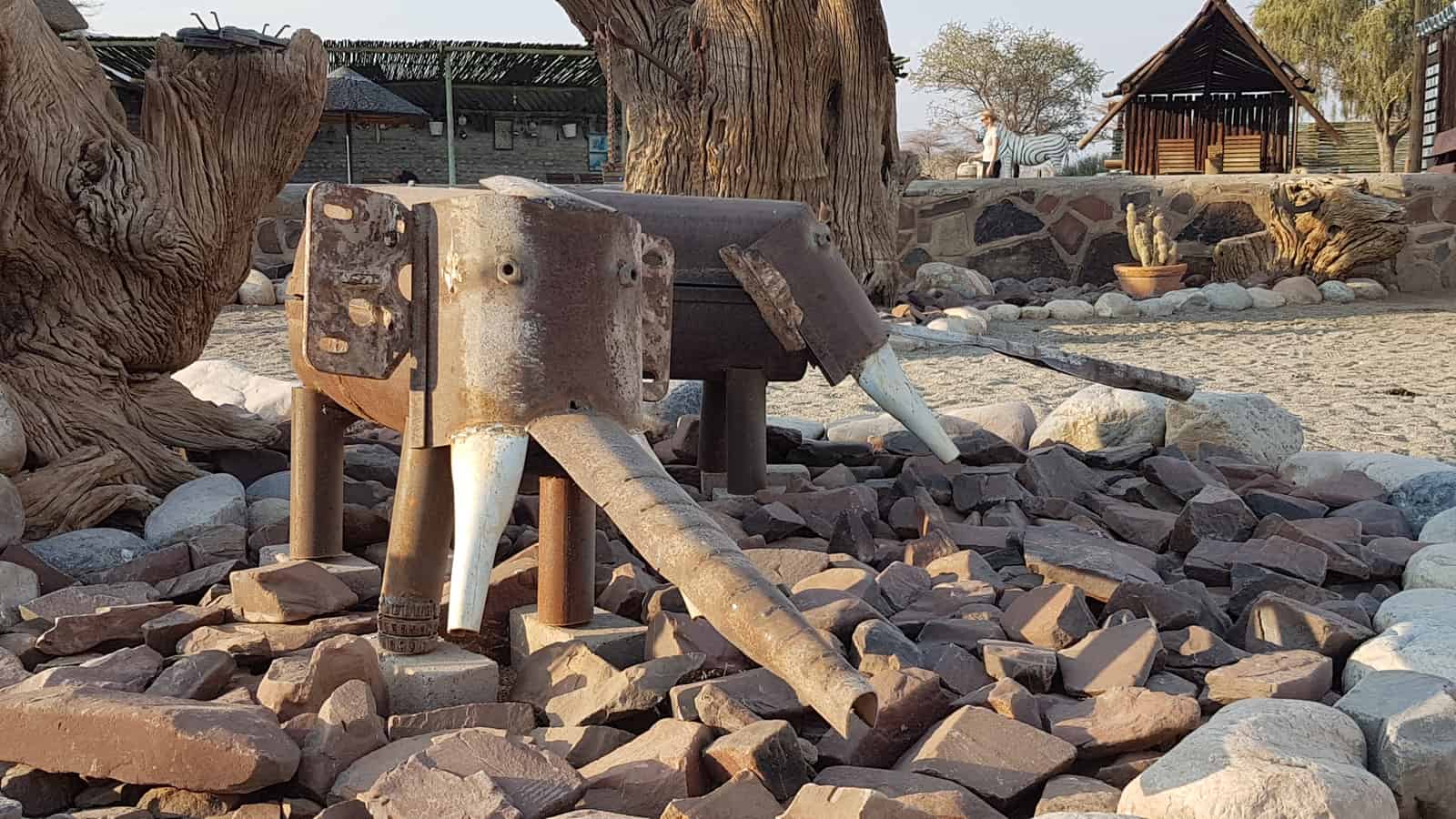The Namib desert spans over 95,000km² of coastline in Namibia and Angola. Its huge sand dunes are among the highest dunes in the world, and the UNESCO declared it “World Heritage” in 2013. Most well known are the dunes in Sossusvlei, that reach heights of more than 350 meters. With their red color, they stand in sharp contrast to the yellow-white vleis. A vlei is a shallow, often only seasonally filled lake. When the water vanishes, salt or clay pans remain – such as in Sossusvlei in Namibia.
Sossusvlei and Dead Vlei
Sossusvlei and the nearby Dead Vlei are Namibia’s most often-photographed landmarks. Especially the Dead Vlei offers amazing photo spots. It used to be an oasis with several acacia trees, but it hasn’t seen water for such a long time that all the trees in the valley died. Over time, the Namib sun has relentlessly burned their stems. Now, many of them have a dark-brown to black color. Together with the white clay of the vlei, the red of the 300m high sand dunes, and the blue of the sky, Dead Vlei creates a unique scenery full of sharp contrasts.
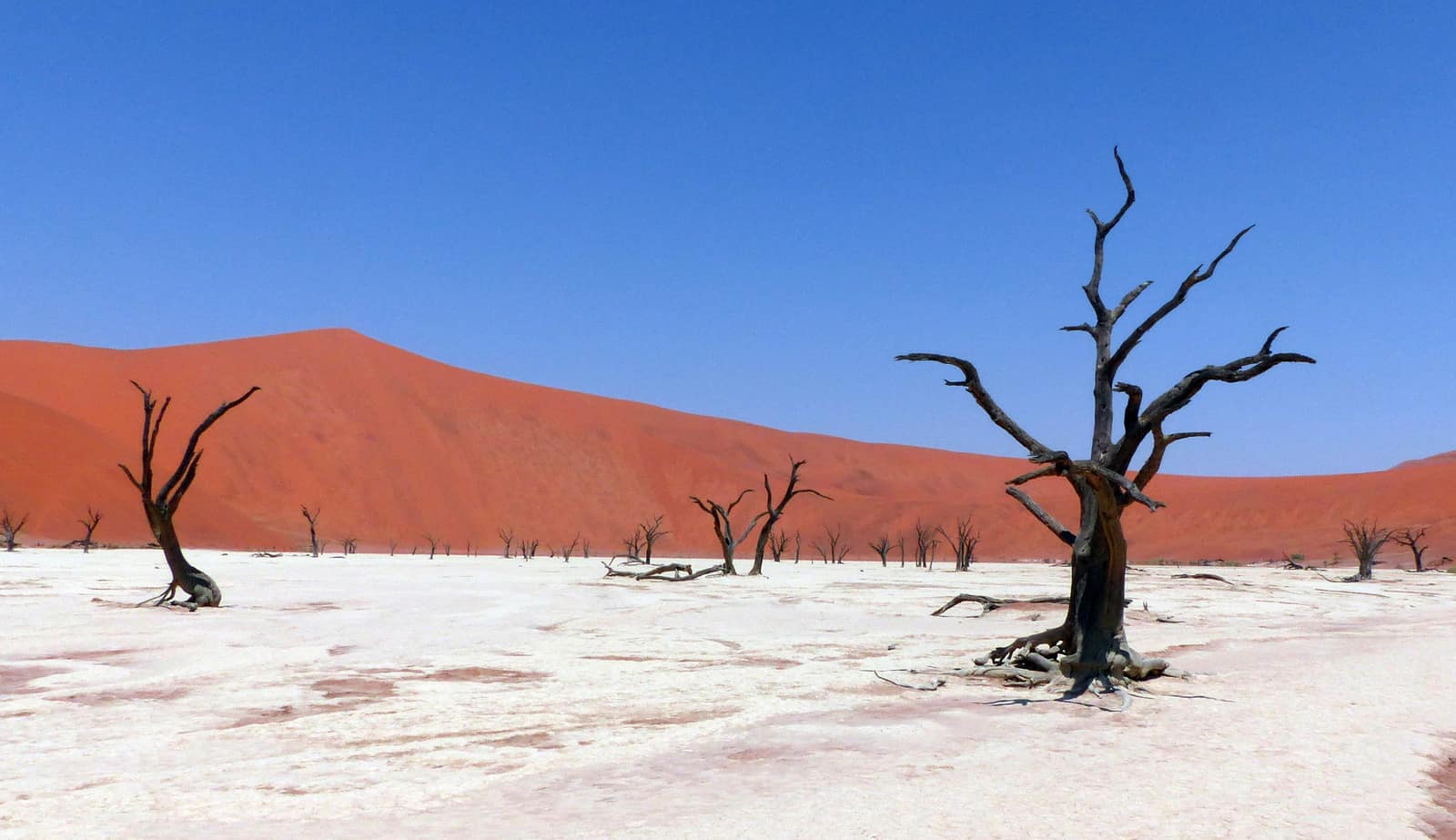
Apparently, Dead Vlei is quite full of tourists in the early morning and the evening, when the desert temperatures are more tolerable. A good advice from our farm manager: If you go there in the morning, skip the long queue at the permit office near the park entrance. The permit is only checked when you leave the park, so you can pay just before leaving. Alternatively, you can also go there at noon, like we did. We were lucky to have Dead Vlei all for ourselves, though we “paid” for this privilege with an excruciating walk from the parking place to the vlei. Even though the walk is “just” 20 minutes per direction, doing it at 50°C+ degrees at lunchtime is super exhausting. Even the NWR park manager approached us to ask for water when we returned to our car!

Sossusvlei: Dune 45; 4×4 Trail; Tsauchab River Viewpoint
Some more words on Sossusvlei: If you haven’t spent all your energy by stomping through the deep, hot desert sand at Dead Vlei, you can also climb Dune 45 (which is 45km away from the park entrance, thus the name). At more than 350 meters, it’s one of the highest sand dunes in the world. From the top you really grasp how large and wide the Namib desert actually is.
A little bit closer to the entrance, at km 24, you can drive to a small plateau which provides a good view of the riverbed of the Tsauchab River. In September and October, the river is dry – like most of the rivers in Namibia –, but during the rainy season, it brings water as far as to Sossusvlei. The Tsauchab’s floods then bring the sediments that created the vleis.
Directly at the entrance, keep your eyes open for the oryx antelopes that feed on the trees in the Tsauchab river bed. They are so used to the tourists that some of them even walk around the Sossuvlei campsite!
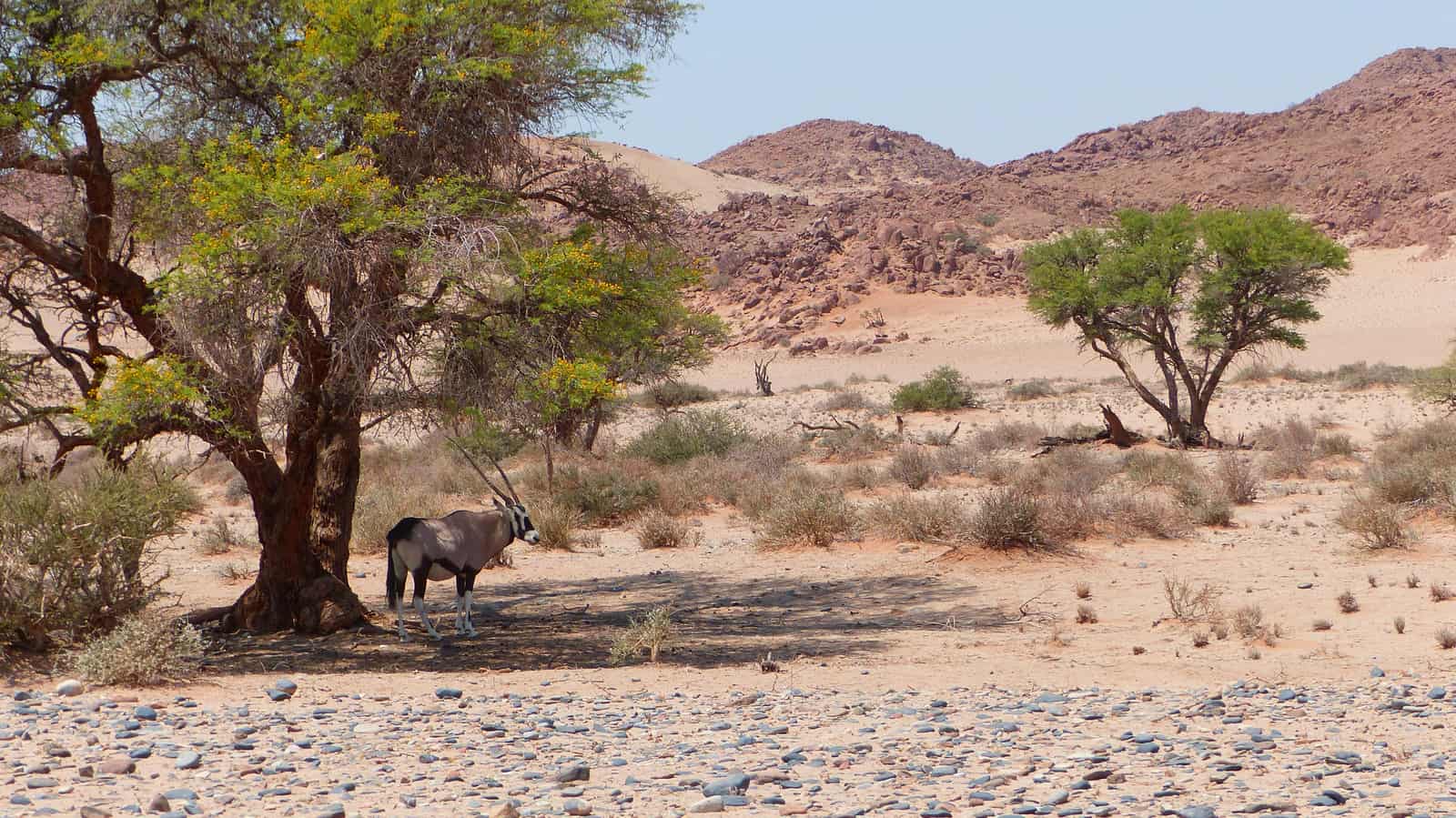
Important: If you want to visit Sossuvlei, be aware that you can only access the last 5 kilometers with a 4×4 vehicle. If you don’t have a 4×4, or don’t want to drive through deep sand (which is actually quite fun), you can take a shuttle provided by the park.
Sesriem Canyon
If you turn sharp left from the Sesriem entrance and follow the gravel pad for 5km, you can enter the Sesriem Canyon. The canyon is just as impressive as Sossusvlei. 30m high walls flank a narrow gorge that can be hiked in two directions. The walls provide nesting ground for a huge number of swallows, and monkeys roam the cliff’s edges. One monkey threw some feces at us and just missed us by 30 centimeters, so watch out! ?
If you follow the hiking trail to the left, you’ll end up in a cathedral-like dead end. It’s hard to describe the awesomeness of this place, but I guess the photo speaks for itself!

Towards the right, the canyon gradually gets wider and wider, and less spectacular. If you only visit the left side, you won’t miss out.
Our Campsite: Tsauchab River Camp
There are many excellent campsites around Sossuvlei. Our first choice, NWR Sesriem Camp, was already fully booked half a year before our Namibia trip. Instead, we booked at Tsauchab River Camp, 60km north-west of the park’s entrance. We didn’t regret it!
At the main building, you can enjoy the marvelous metal art, relax at the pool, use the free (!) wi-fi, have a drink at the bar, play pool billiard or pet the tame Springbok. Yes, there’s a Springbok living at Tsauchab River Camp, and he really likes to be petted! ?
The campsites are scattered over a huge area. They are grouped into smaller camps. Each camp has its own camp manager, who takes care of the guests, heats the fire for warm showers and lights candles on the paths in the evening. We stayed at Naukluft View Camp. The camping spots are close to nature in a small forest. After sunset, lots of insects wake up, so unless you like your food “Hakuna Matata”, we warmly recommend that you eat before sunset. We eventually ended eating in the car… ?
There are ample hiking opportunities in the area. We did the 1.5km long Wild Fig Stroll through a beautiful forest. Watch out! There’s a leopard living in the forest, which at least in theory can be quite dangerous. However, it’s so shy that it’s very unlikely that you’ll meet it.
Other hikes are the Kudu Trail (6km), the Quiver Tree Hike (4.1km) and the 22km long Mountain Zebra Hike. We hiked the Kudu Trail, which goes up an extremely steep path onto the top of a mountain. We didn’t see any kudu antelopes, but the view from the mountain top was just as rewarding!
OUR TRAVEL ROUTE FOR THE ENTIRE TRIP
If you want to learn what else we experienced in Namibia, check out our travel route for the entire trip – including reviews of the most exciting places!
- Last Stop: Tiras Mountains
- Next Stop: Swakopmund
- Overview: Our entire route
